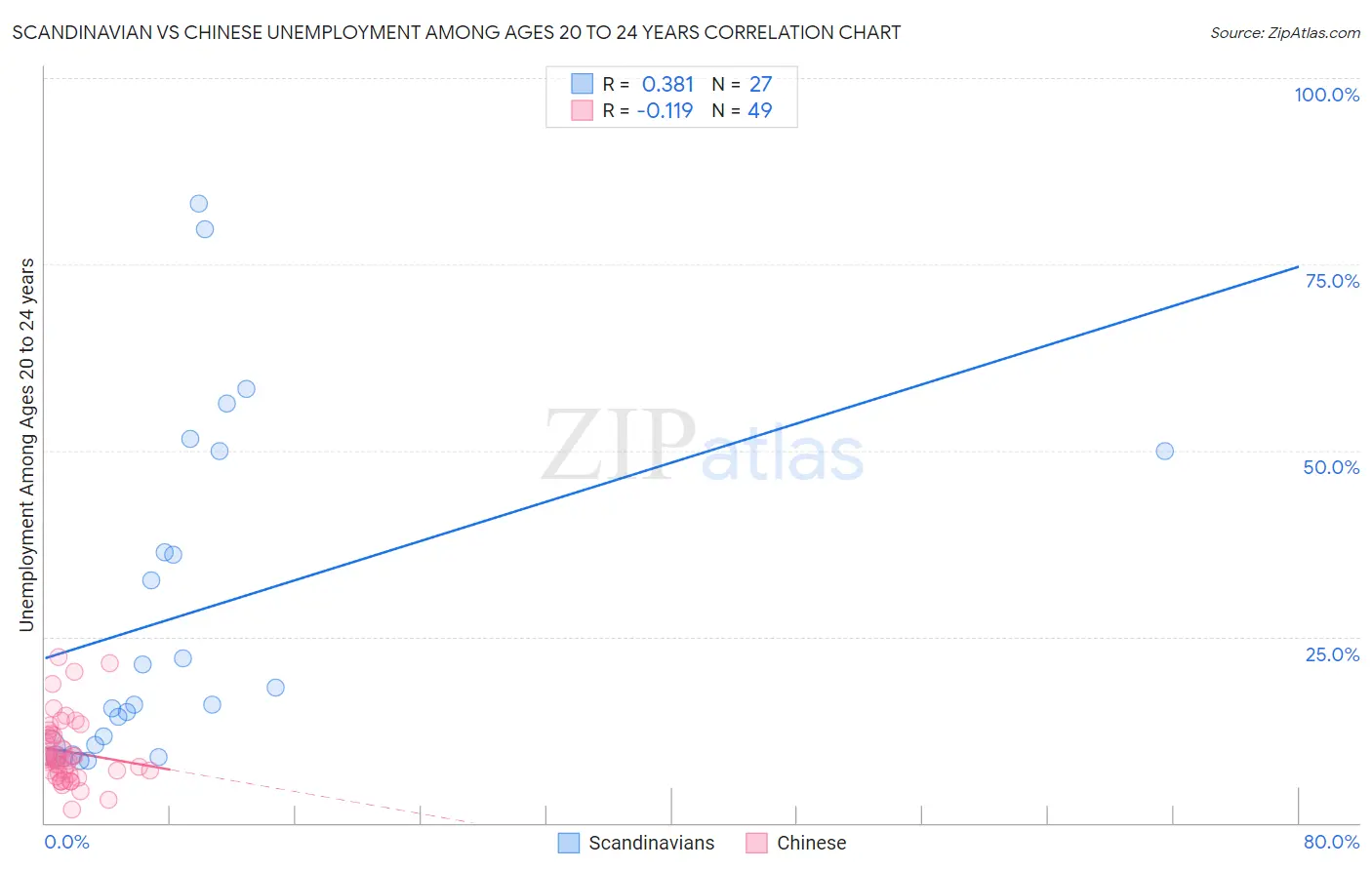Scandinavian vs Chinese Unemployment Among Ages 20 to 24 years
COMPARE
Scandinavian
Chinese
Unemployment Among Ages 20 to 24 years
Unemployment Among Ages 20 to 24 years Comparison
Scandinavians
Chinese
9.5%
UNEMPLOYMENT AMONG AGES 20 TO 24 YEARS
100.0/ 100
METRIC RATING
30th/ 347
METRIC RANK
9.4%
UNEMPLOYMENT AMONG AGES 20 TO 24 YEARS
100.0/ 100
METRIC RATING
18th/ 347
METRIC RANK
Scandinavian vs Chinese Unemployment Among Ages 20 to 24 years Correlation Chart
The statistical analysis conducted on geographies consisting of 445,642,981 people shows a mild positive correlation between the proportion of Scandinavians and unemployment rate among population between the ages 20 and 24 in the United States with a correlation coefficient (R) of 0.381 and weighted average of 9.5%. Similarly, the statistical analysis conducted on geographies consisting of 64,258,935 people shows a poor negative correlation between the proportion of Chinese and unemployment rate among population between the ages 20 and 24 in the United States with a correlation coefficient (R) of -0.119 and weighted average of 9.4%, a difference of 1.7%.

Unemployment Among Ages 20 to 24 years Correlation Summary
| Measurement | Scandinavian | Chinese |
| Minimum | 8.3% | 1.8% |
| Maximum | 83.1% | 22.3% |
| Range | 74.7% | 20.5% |
| Mean | 28.0% | 9.6% |
| Median | 15.9% | 8.5% |
| Interquartile 25% (IQ1) | 10.1% | 6.7% |
| Interquartile 75% (IQ3) | 50.0% | 11.8% |
| Interquartile Range (IQR) | 39.9% | 5.2% |
| Standard Deviation (Sample) | 22.6% | 4.5% |
| Standard Deviation (Population) | 22.1% | 4.4% |
Demographics Similar to Scandinavians and Chinese by Unemployment Among Ages 20 to 24 years
In terms of unemployment among ages 20 to 24 years, the demographic groups most similar to Scandinavians are Immigrants from North Macedonia (9.5%, a difference of 0.010%), Immigrants from Afghanistan (9.5%, a difference of 0.020%), Immigrants from Eastern Africa (9.5%, a difference of 0.090%), Immigrants from Zimbabwe (9.5%, a difference of 0.11%), and Cambodian (9.5%, a difference of 0.13%). Similarly, the demographic groups most similar to Chinese are Hmong (9.4%, a difference of 0.12%), Osage (9.4%, a difference of 0.13%), Immigrants from Bosnia and Herzegovina (9.4%, a difference of 0.13%), Tongan (9.4%, a difference of 0.40%), and Immigrants from Nepal (9.4%, a difference of 0.41%).
| Demographics | Rating | Rank | Unemployment Among Ages 20 to 24 years |
| Slovenes | 100.0 /100 | #14 | Exceptional 9.3% |
| Immigrants | Sudan | 100.0 /100 | #15 | Exceptional 9.3% |
| Danes | 100.0 /100 | #16 | Exceptional 9.3% |
| Czechs | 100.0 /100 | #17 | Exceptional 9.3% |
| Chinese | 100.0 /100 | #18 | Exceptional 9.4% |
| Hmong | 100.0 /100 | #19 | Exceptional 9.4% |
| Osage | 100.0 /100 | #20 | Exceptional 9.4% |
| Immigrants | Bosnia and Herzegovina | 100.0 /100 | #21 | Exceptional 9.4% |
| Tongans | 100.0 /100 | #22 | Exceptional 9.4% |
| Immigrants | Nepal | 100.0 /100 | #23 | Exceptional 9.4% |
| Taiwanese | 100.0 /100 | #24 | Exceptional 9.4% |
| Immigrants | Eritrea | 100.0 /100 | #25 | Exceptional 9.5% |
| Swedes | 100.0 /100 | #26 | Exceptional 9.5% |
| Immigrants | Zimbabwe | 100.0 /100 | #27 | Exceptional 9.5% |
| Immigrants | Afghanistan | 100.0 /100 | #28 | Exceptional 9.5% |
| Immigrants | North Macedonia | 100.0 /100 | #29 | Exceptional 9.5% |
| Scandinavians | 100.0 /100 | #30 | Exceptional 9.5% |
| Immigrants | Eastern Africa | 100.0 /100 | #31 | Exceptional 9.5% |
| Cambodians | 100.0 /100 | #32 | Exceptional 9.5% |
| Australians | 100.0 /100 | #33 | Exceptional 9.6% |
| Yugoslavians | 100.0 /100 | #34 | Exceptional 9.6% |